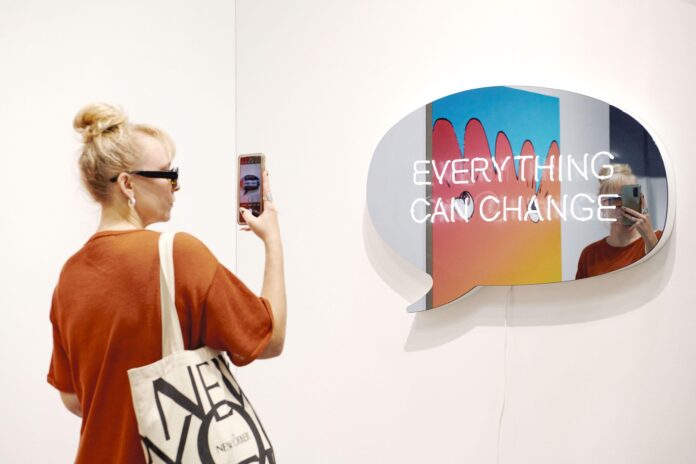This summer, the London-based fair and media franchise Frieze, which stages five major fairs around the world, announced that it had acquired The Armory Show and Expo Chicago. What does Frieze’s acquisition mean for the future of The Armory Show, which was founded as a hotel fair in 1994 by four New York dealers?
For now, Nicole Berry, the fair’s executive director since 2017, remains in charge and no staff, schedule or format changes have been announced. The fair will remain in its September slot at the Javits Center, New York’s main convention centre, with upwards of 200 exhibitors taking part.
Dealers who have exhibited at both The Armory Show and other Frieze fairs, including Frieze New York in the spring, have seen no changes in the run up to the first edition of “New York’s fair” since its acquisition. Most suspect Frieze will bring greater international participation to Armory, both among collectors and dealers, though some wonder whether this will impact the fair’s local character.
Hollis Taggart, who has exhibited with his eponymous Chelsea gallery since The Armory Show’s early years, has high hopes.
“Adding the Frieze branding is a big boost. The key thing is that they’re keeping the same personnel. They run a clean, well-organised show,” Taggart says. “It can only improve the global stature of the Armory.” In terms of audience, Taggart expects the fair “to get more international attention, especially from the Far East”.
Claudia Altman-Siegel, the director of Altman Siegel Gallery in San Francisco, also welcomes the news. “Nicole Berry has done a great job with The Armory, and Frieze will just up the level of glamour and international attention,” she says.
“The audience of Frieze has changed a lot since Endeavor has taken it over,” Altman-Siegel adds, referring to the Hollywood talent agency and entertainment company that, in 2016, bought a majority stake in Frieze. “There are more corporate people involved and a wider reach of people who aren’t strictly from the art world, which has its benefits and problems.” Armory, she says, has always felt like a “fun, local thing for New Yorkers” as opposed to a star-studded event.
Andrew Freiser, a partner at Fredericks & Freiser in New York, believes that the acquisition will preserve, rather than diminish, The Armory Show’s unique, local qualities. “It’s such a venerable New York brand, like the Odeon or the Strand, and I’m excited that a global powerhouse like Frieze can help ensure that it stays that way,” he says.
Coming calendar shuffle?
David Cleaton-Thomas, the director of Cristea Roberts Gallery in London, says that The Armory Show “has been a fantastic fair for years with a clear brand”. Its future under Frieze, he says, “depends on whether they will merge the [New York] fairs”. He points out that the timing of Kiaf Seoul and Frieze Seoul—which overlap with The Armory Show—could present problems down the line.
Glenn Scott Wright, the director of London’s Victoria Miro, who has been on The Armory Show’s selection committee for over a decade, believes that the elimination of competition between the fair and Frieze will be mutually beneficial. “It was probably a little difficult to have both fairs in the same city, vying for the same space and clients,” he says. “If they can work together, Frieze now has the Armory’s best interests at heart.”
He adds that “The Javits Center sounds like the ideal location—much greater capacity” compared with Frieze New York’s nearby venue, The Shed, which can accommodate fewer than 70 galleries. “I’m guessing that that has been a prime reason for Frieze taking over the Armory.” In terms of the future, he wonders whether Frieze’s plan is to “run one show or continue running both”.
Toby Clarke, the director of Vigo Gallery in London, is slightly wistful about the acquisition. “I hope the Armory, which I have always loved exhibiting at, retains its own identity,” he says. “It is maybe inevitable but at the same time a little sad that fairs are becoming amalgamated so much.”
Lost in consolidation
Clarke emphasises the importance of supporting smaller galleries and fairs in an industry increasingly dominated by Frieze and its main rival, the Swiss firm Art Basel.
“We should value smaller groups like the 1-54 Contemporary African Art Fair, Untitled and The Art Assembly, to make sure there is choice and that galleries are able to break through,” he says. “We are a lucky small gallery but the [committee] system, with its peer-reviewed selection, seems outdated and is not conducive to helping smaller galleries, where a lot of the risks are taken and discoveries made.”
His thoughts are echoed by Katelijne De Backer, who was The Armory Show’s executive director from 2000 to 2011. “I kind of miss when The Armory Show was at the piers,” she says, referring to the fair’s long-time locale on piers 92 and 94 in the Hudson River. “It had so much more of a New York feel than the Javits Center. I miss the days when it was a little more bohemian. All the big fairs now are very polished and perfect. They have to be, to compete with each other.”
However, she adds: “Everything in the art world is changing so much.” The Armory Show “was such an elite little thing for people interested in art. But the big art fairs have made art much more democratic; that’s a good thing.”
“I hope that Frieze and Basel keep giving opportunities to smaller galleries. That is what makes the fairs interesting. Yes, you have the big galleries, but to discover a newer, younger gallery—that is what collectors want.”

























